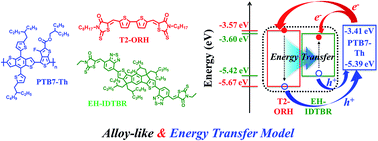Enhanced efficiency and stability of PTB7-Th-based multi-non-fullerene solar cells enabled by the working mechanism of the coexisting alloy-like structure and energy transfer model†
Abstract
A simple-structured nonfullerene acceptor (NFA), T2-ORH, consisting of a bithiophene core and octyl-substituted rhodanine ends is utilized as the third component in ternary-blend solar cells with PTB7-Th and EH-IDTBr as host materials. T2-ORH is a wide band gap NFA and specially contributes to light absorption, which provides complimentary absorption with a low band gap acceptor, EH-IDTBR. In the ternary device, a PCE of 11.55%, a short circuit current (JSC) of 17.51 mA cm−2, a fill factor (FF) of 63% and an open circuit voltage (VOC) of 1.05 V were achieved with a 1 : 1 : 1 blend ratio. In this ternary system, it is estimated that the two NFAs work as one alloy-like acceptor and energy transfer model from T2-ORH to EH-IDTBR for efficient ternary-blend organic solar cells (OSCs). On conducting thermal, light, and air-process stability tests, the ternary-blend systems show superior stability performance owing to the formation of a stable and robust morphology. Finally, we fabricated a large-scale device (5 cm × 5 cm substrate, 13.5 cm2 aperture size, and a geometric FF of 54%) with the same ternary system. The sub-module ternary-blend OSCs displayed the highest PCE of 10.08% with JSC = 2.83 mA cm−2, VOC = 6.36 V and FF = 56%. As a result, ternary-blend OSCs show tremendous promise for use in actual applications.



 Please wait while we load your content...
Please wait while we load your content...